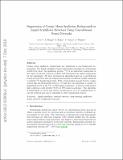Suppression of cosmic muon spallation backgrounds in liquid scintillator detectors using convolutional neural networks
Author(s)
Li, A; Elagin, A; Fraker, S; Grant, C; Winslow, L
DownloadSubmitted version (1.030Mb)
Publisher with Creative Commons License
Publisher with Creative Commons License
Creative Commons Attribution
Terms of use
Metadata
Show full item recordAbstract
© 2019 Cosmic muon spallation backgrounds are ubiquitous in low-background experiments. For liquid scintillator-based experiments searching for neutrinoless double-beta decay, the spallation product 10C is an important background in the region of interest between 2–3MeV and determines the depth requirement for the experiment. We have developed an algorithm based on a convolutional neural network (CNN) that uses the temporal and spatial correlations in light emissions to identify 10C background events. Using a simple Monte Carlo simulation of a monolithic liquid scintillator detector like KamLAND, we find that the algorithm is capable of identifying 61.6% of the 10C at 90% signal acceptance, with a total uncertainty of 2.7%. A detector with perfect light collection can identify 98.2% at 90% signal acceptance. The algorithm is independent of vertex and energy reconstruction, so it is complementary to other frequently-used methods and can be expanded to other background sources. This work forms the foundation for more in depth studies of detector-dependent effects and more advanced CNN-based algorithms.
Date issued
2019Department
Massachusetts Institute of Technology. Laboratory for Nuclear ScienceJournal
Nuclear Instruments and Methods in Physics Research, Section A: Accelerators, Spectrometers, Detectors and Associated Equipment
Publisher
Elsevier BV